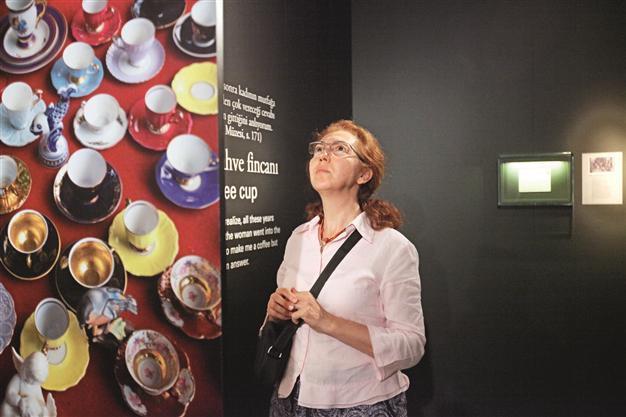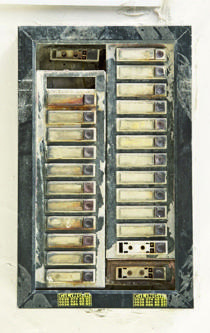Istanbul exhibition reveals modest musings on ‘An Innocent City’
Emrah Güler

‘An Innocent City: Modest Musings on Everyday Istanbul,’ which is open until Sep 3, aims to be an interactive experience, with visitors invited to share their stories in the exhibition’s introductory statement.
“The handkerchief in box 9 is Füsun’s white childhood handkerchief with embroidery on the corner.” Füsun, referred to here, is one half of the love story in Nobel prize-winning author Orhan Pamuk’s 2008 novel “The Museum of Innocence.” Those familiar with the novel know that Füsun and Kemal’s story, and the objects central to the narrative, have been brought to real life with the subsequent actual Museum of Innocence in Istanbul’s Cihangir neighborhood.While “The Museum of Innocence” was brought to life with the museum, which displays in wooden cabinets some 70 objects, collected and curated by Pamuk himself, a new exhibition “An Innocent City: Modest Musings on Everyday Istanbul” at Koç University’s Research Center for Anatolian Civilizations (RCAC) breathes new life into the novel and the museum, once again recreating an Istanbul through everyday objects.
“Füsun’s white childhood handkerchief” is the inspiration for another handkerchief in the exhibition, one of the 12 object displayed through story, photography, cartography and graphic design, as well as informal, temporary loans from members of the local community. Some of the other objects are a hairpin, a key, a cologne bottle, and a glass of the alcoholic drink rakı, each inspired by the Museum of Innocence and selected by graduate students from Koç University, who searched the streets of Istanbul in an attempt to find the real-life counterpoints of these objects.
 By following the lives of everyday things, the students encountered alternative perspectives on the cultural heritage of Istanbul. Each student has created a narration of Istanbul unique to them, pondering over everyday objects such as a key or a bottle of the popular fizzy drink “gazoz.” The stories are of multiple Istanbuls - of today, of the recent past, and of one shrouded in nostalgia.
By following the lives of everyday things, the students encountered alternative perspectives on the cultural heritage of Istanbul. Each student has created a narration of Istanbul unique to them, pondering over everyday objects such as a key or a bottle of the popular fizzy drink “gazoz.” The stories are of multiple Istanbuls - of today, of the recent past, and of one shrouded in nostalgia. [HH] Visitors become actors of the exhibition
Accompanying the stories are photographs of the 12 objects captured by Hasan Deniz, whose recent solo exhibition “Alte Liebe” similarly explored cities that he has traveled to and served as a landscape of distant places, but whose pieces were all ultimately devoid of a sense of time and place. The effect is similar here, as Deniz’s photos of the objects recreate a sense of nostalgia that is at once familiar and unique.
Ian Alden Russell, the curator of “An Innocent City,” is a designer and assistant professor at Koç University specializing in contemporary art and cultural heritage. Previously, he was Curator of the David Winton Bell Gallery at Brown University, where he curated many notable exhibitions including the premiers of “The Strangest Fruit” by Vincent Valdez, and Iraqi-American artist Wafaa Bilal’s “The Ashes Series.” Russell shared with the Hürriyet Daily News his thoughts on the exhibition and elaborated on the question of “modesty,” a definitive feature of the exhibition.
In particular, the exhibition aims to be an interactive experience, with visitors invited to share their stories in its introductory statement. “We’ve incorporated a few ways in which visitors can contribute stories in response to the exhibition. Central to the exhibition is a step-by-step guide printed on the brochure for how visitors can create their own modest musings,” said Russell.
“We’ve created some special postcards - one for each object - that visitors can write a story on and add it to a wall of postcards at the exhibition. They can also mail them to the gallery later or take them away and send them to someone else one day,” he added. There are also blank pages in the exhibition’s book “where visitors can write their own modest musings – either on our exhibition or any other museum,” he also said.
 ‘Museum of Innocence’ vs ‘An Innocent City’
‘Museum of Innocence’ vs ‘An Innocent City’To accompany the opening of his “Museum of Innocence” in 2012, Orhan Pamuk issued a manifesto in which he stated that “museums should represent humanity … the story of individuals more readily reveals the depths of humanity … we are fed up with museums that attempt to tell the story of a group, a nation, a company, a state and so on.”
Russell said his project was inspired by this “Modest Manifesto for Museums.”
“His call-to-action was inspiring and I felt it was important to attempt to put the ideas into practice. Pamuk’s call and this exhibition are contributions to an ongoing negotiation over what museums and heritage can be in our lives and in our communities,” Russell said. “We hope that this will be only one of what will be many projects that are inspired by this manifesto, widening the conversation about how we compose and present history in Istanbul to reach a greater audience and involve the public more actively in the making of these exhibitions and stories.”
Nevertheless, he stressed that visiting the “Museum of Innocence” and visiting the “An Innocent City” exhibition were two distinct experiences. “The objects in the Museum of Innocence are presented in composed scenes inside glass cases. While the objects are from everyday life, visitors are kept at a distance from the objects that might be common to their lives. However, we wanted to find a way to allow people reach through the glass of museum cases and celebrate and share new stories inspired by these objects,” Russell said.
“This led to the decision for ‘An Innocent City’ to have photographic displays that visitors can open to read stories and view illustrations – as well as the opportunities to contribute new stories of their own,” said Russell. “In this sense, we hope that ‘An Innocent City’ will be a temporary complement to the experience of the ‘Museum of Innocence,’ offering possibilities for how visitors might be able to begin to make their own responses to Pamuk’s manifesto by visiting museums and writing their own modest musings.”
“An Innocent City: Modest Musings on Everyday Istanbul” can be seen at the Research Centre for Anatolian Civilizations on Istanbul’s İstiklal Avenue until Sept. 3.
















